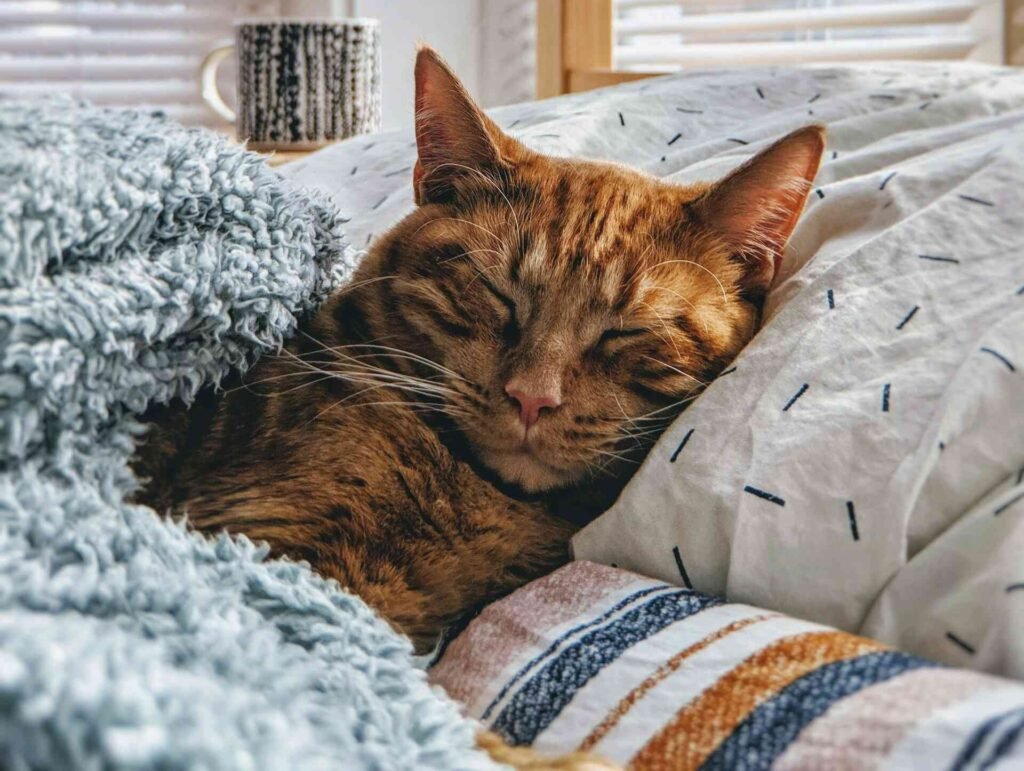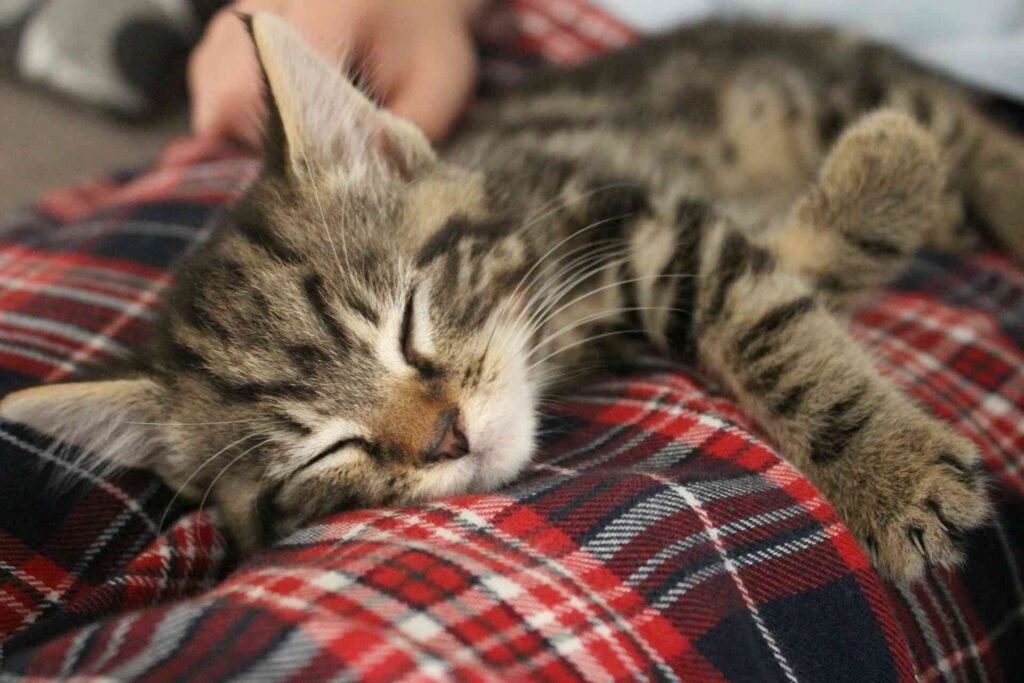We’ve all witnessed it, that endearing moment when our sleeping cat suddenly twitches their whiskers, frantically paddles their paws in the air, or makes tiny chirping sounds during a deep slumber. These adorable sleep behaviors often leave us wondering: do cats dream? And if they do, what goes on in those mysterious feline minds when they drift off to sleep?

The Fascinating Science Behind Cat Dreams
Just like humans, cats cycle through different stages of sleep, including the rapid eye movement (REM) phase, the period when dreams typically occur. During REM sleep, a cat’s brain activity closely resembles their wakeful state, suggesting that yes, cats do indeed dream.
When our feline friends enter dreamland, their brains process and sort through experiences from their day. Those paw twitches and whisker movements you notice aren’t random, they’re often your cat mentally reliving activities like hunting, playing, or exploring their territory.
Signs Your Cat Is Dreaming
How can you tell when your cat has entered the dream world? Look for these telltale indicators:
- Whisker and facial twitching: Subtle movements around their face often indicate REM sleep
- Paw movements: Those adorable “air paddles” mimic running or playing behaviors
- Quiet vocalizations: Soft chirps, purrs, or even tiny meows during sleep
- Rapid eye movements: Though their eyes remain closed, you might notice quick movements beneath the eyelids
- Body twitches: Small jerking motions of the tail, legs, or body
These behaviors typically last just a few minutes before your cat returns to deeper, more still sleep. The next time you spot these signs, you’re likely witnessing your feline friend in the midst of a dream adventure!
Do Cats Have Nightmares?
Just as dreams reflect the positive experiences in our cats’ lives, it’s reasonable to wonder: do cats have bad dreams or nightmares too? Animal behaviorists believe the answer is yes.
When cats display more intense reactions during sleep, such as suddenly waking with dilated pupils, appearing startled, or even hissing or growling, they may have experienced something unsettling in their dream state. These potential cat nightmares might reflect negative experiences or fears, just as they do for humans.
For cats with traumatic backgrounds or those who have experienced frightening situations, bad dreams may be more common. This is especially relevant for rescue cats who might carry emotional baggage from their past.
The Connection Between Sleep Positions and Dreams
Interestingly, your cat’s preferred sleeping position might offer clues about their dream state. As detailed in our guide on Cat Sleeping Positions and What They Mean, certain postures indicate deeper levels of comfort and security, potentially setting the stage for more vivid dreams.
| Sleep Position | Dream Likelihood | Sleep Quality |
|---|---|---|
| Curled up ball | Moderate dreaming | Security-focused sleep |
| Belly exposed | High dream activity | Deep, trusting sleep |
| Loaf position | Light dreaming | Alert rest state |
| Stretched out | Intense REM cycles | Complete relaxation |

When cats sleep in positions exhibiting complete vulnerability, like with their belly exposed, they’re often experiencing their most intense dream states because they feel secure enough to fully surrender to deep sleep.
Should You Wake a Dreaming Cat?
When we notice our cat having what appears to be a bad dream, twitching more violently or making distressed sounds, our first instinct might be to comfort them by waking them up. However, this isn’t recommended.
Just like humans, cats need to complete their sleep cycles naturally. Interrupting a cat during REM sleep can cause confusion, disorientation, and even stress. Additionally, a startled cat might reflexively scratch or bite if awakened suddenly from an intense dream.
Instead of waking them, simply be present and ready to offer gentle reassurance if they wake naturally from what seems to be a bad dream. Creating a consistently safe sleeping environment helps support positive sleep experiences overall.
Enhancing Your Cat’s Dream Life
Want to encourage pleasant dreams for your feline friend? Consider these approaches:
- Create secure sleeping spaces – Cats dream best when they feel safe and comfortable
- Establish consistent routines – Regular schedules reduce anxiety that might trigger bad dreams
- Provide stimulating daytime activities – Active cats with fulfilled lives tend to have more positive dream experiences
- Consider calming aids – For anxious cats, pheromone diffusers can create a more relaxing atmosphere
The Remarkable Dream Life of Kittens
Kittens actually dream more frequently than adult cats! This intense dream activity supports their rapid brain development and helps them process the enormous amount of new information they absorb each day.

If you’ve ever watched a sleeping kitten, you’ve likely noticed more pronounced dream behaviors, their tiny bodies seemingly reenacting playful battles or exploratory adventures while sound asleep. This higher dream frequency gradually decreases as they mature, though adult cats remain active dreamers throughout their lives.
Frequently Asked Questions
Do older cats dream differently than younger cats?
Yes, senior cats typically spend less time in REM sleep than their younger counterparts, suggesting they may dream less frequently or intensely. However, their dreams might draw on a richer lifetime of experiences and memories.
Can cats recognize their owners in dreams?
While we can’t know for certain what specific imagery appears in cat dreams, evidence suggests cats likely dream about familiar individuals, including their human companions. Those special bonds you share during waking hours may well continue into their dream world.
Do cats remember their dreams?
Current understanding of animal cognition suggests cats probably don’t consciously recall their dreams the way humans might. However, emotional impressions from dreams may linger, potentially affecting their mood upon waking.
Do indoor cats dream differently than outdoor cats?
Cats dream about their experiences, so indoor and outdoor cats likely have different dream content based on their daily activities. An outdoor cat might dream more about hunting and exploring, while an indoor cat’s dreams might feature toys, windowsill views, and interactions with household members.
The next time you watch your sleeping feline friend twitch and purr, remember you’re witnessing one of nature’s most mysterious phenomena. Their rich dream life represents yet another fascinating aspect of these beloved companions who share our homes and hearts.
Conclusion: The Wonder of Cat Dreams
The evidence is clear, cats do indeed dream, and their dream experiences may be even more vivid and frequent than our own. From the gentle paw twitches of a napping kitten to the occasional midnight meow of a deeply dreaming adult cat, these sleep behaviors offer us a rare glimpse into our pets’ inner lives.
Understanding your cat’s dream patterns can deepen your connection with them and help you provide the security and enrichment they need for healthy sleep. Cats aren’t simply “sleeping all the time”, they’re actively processing, learning, and emotionally developing during those seemingly endless naps.
By respecting our cats’ need for quality sleep and creating environments where they feel safe enough to dream peacefully, we’re supporting an essential aspect of their physical and emotional wellbeing. After all, cats’ dreams are just one more beautiful reminder of the complex, sentient beings with whom we’re fortunate enough to share our lives.
Looking for more? Explore our Cat Health section for more tips like this, visit the Blog for fun and insightful reads, or browse our full Cat Category for everything feline-related, from care to comfort.
Disclaimer: This article is for informational purposes only and does not substitute for professional veterinary advice. Always consult your veterinarian for diagnosis and treatment tailored to your cat’s individual needs. Please verify current product information directly on the retailer’s site before purchasing.
References
- Malinowski, Josie & Scheel, David & McCloskey, Mitchel. (2021). Do animals dream?. Consciousness and Cognition, 95. https://doi.org/10.1016/j.concog.2021.103214
- Manger PR, Siegel JM. Do all mammals dream? J Comp Neurol. 2020; 528: 3198–3204. https://doi.org/10.1002/cne.24860
Check out our most recent articles!
- Cats and Snow: Why Some Love It and Others Don’tSnow isn’t just uncomfortable for many cats, it’s a complete sensory overload. From cold paw pads to wet fur and changed landscapes, winter challenges feline comfort in unexpected ways. Learn how to recognize stress signals and create cozy alternatives for snow-averse cats.
- Christmas Names for Cats: From Classic to Creative Holiday IdeasNaming your holiday cat goes beyond festive fun. Discover why Christmas-inspired names age beautifully, spark instant connections with fellow pet lovers, and capture the warmth cats bring to our homes during the most magical season of the year.
- How to Keep Your Cat From Drinking Christmas Tree WaterYour cat’s obsession with Christmas tree water isn’t just annoying, it’s genuinely dangerous. From harmful bacteria to toxic additives, that festive reservoir poses real health risks. Discover practical solutions that protect your pet without sacrificing holiday cheer.
- Best Cat Toys for Christmas: The Ultimate Guide to Holiday JoyNot all Christmas gifts end up under the tree, some get batted across the floor at 3 AM. Explore the wonderful world of holiday cat toys that match your feline’s personality, from plush companions for cuddlers to high-tech options for the eternally energetic.
- Are Fake Christmas Trees Safe for Cats? A Holiday Safety GuideThat beautiful Christmas tree might look festive to you, but to your cat, it’s an irresistible climbing gym with built-in toys. Find out whether artificial trees are truly safer for cats and discover the hidden dangers lurking in your holiday decorations.
- The Best Christmas Gifts for Cats That’ll Actually Get Used (Not Ignored)Not all Christmas gifts land on the nice list with our feline friends. Discover which presents actually spark joy in cats and which ones end up gathering dust under the couch by New Year’s Day.
- Do Cats Eat Less in Winter? How Cold Weather Affects Your Cat’s AppetiteWinter brings more than just cold weather, it can completely change your cat’s eating habits. From bored indoor cats to outdoor ferals fighting to survive, discover what’s really driving those appetite changes and how to respond appropriately.
- Are Humidifiers Good for Cats? A Complete Safety & Health GuideNot all humidifiers are cat-safe, and some common practices could be toxic. Learn why cool mist beats warm mist, why essential oils are dangerous for felines, and how proper humidity levels between 30-50% support your cat’s breathing and coat health.
- How to Protect Leather Furniture From Cats (Without Losing Your Mind)Leather furniture and cat claws seem like natural enemies, but they don’t have to be. Learn why your cat is drawn to that expensive couch in the first place, and how simple redirects can save your furniture while keeping your cat’s natural behaviors satisfied.
- The Best Material for Cat Bowls: Protect Your Cat from BacteriaStainless steel, ceramic, or plastic, which material keeps your cat healthiest? We break down the science behind cat bowl materials, revealing why some harbor bacteria and others last decades without compromising your feline’s wellbeing.










